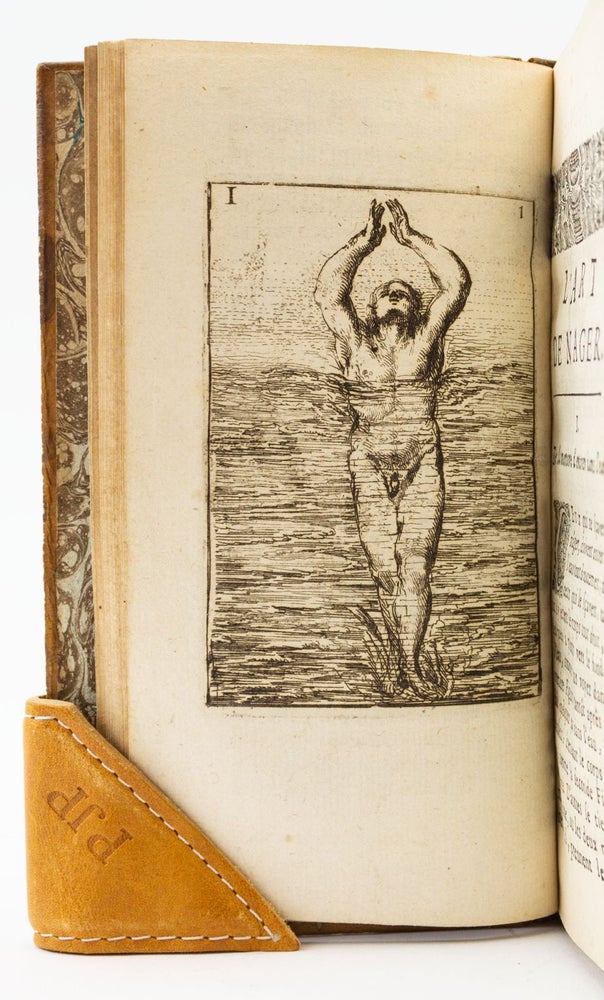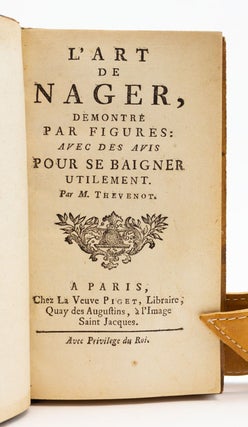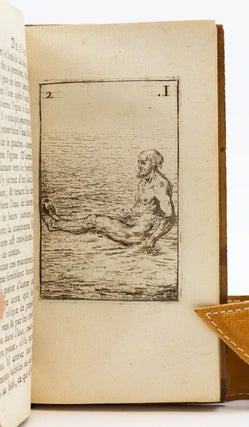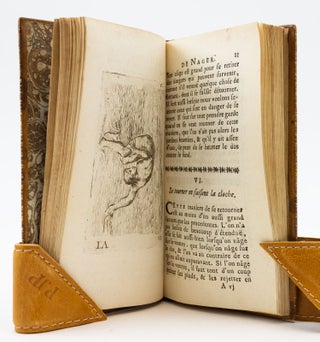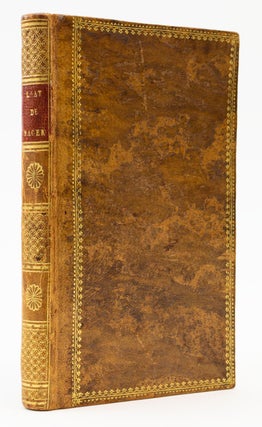L'ART DE NAGER: DÉMONTRÉ PAR FIGURES, AVEC DES AVIS POUR SE BAIGNER UTILEMENT.
(Paris: Chez La Veuve Piget, s.d. [but T. Moette, 1696]). 150 x 82 mm. (5 7/8 x 3 1/4"). 6 p.l., xii, 47 pp. FIRST EDITION (later title page).
Early 19th century marbled sheep, covers with cresting gilt roll border, smooth spine divided into compartments by thick and thin gilt rules, these either filled with a lattice of interlocking gilt circles or with gilt flower at center, red roan label, marbled endpapers. With 35 engravings by Charles Moette showing proper swimming technique. ◆Lower covers with minor loss of patina due to insect activity, extremities just a trifle rubbed, mild marginal foxing to first and last few text leaves, but AN EXTREMELY FINE COPY, QUITE CLEAN, FRESH, AND BRIGHT internally, in a well-preserved binding.
This is as fine a copy as one could hope to find of the charmingly illustrated first edition of the first French work on swimming. In the history of swimming publications, it was preceded only by the 1538 "Colymbetes" by the German professor of languages Nicolaus Winmann, the 1587 "De Arte Natandi" by the Englishman Everard Digby, and the 1595 English translation and adaptation of that work by Christopher Middleton. Thévenot mainly copied Digby's work, and for good reason. Whereas Digby was reputed to be a master swimmer, Thévenot was said to be entirely unable to swim. At the time, that put him in good company, as an ability to swim was not common among his contemporaries, and swimming was generally viewed as a skill cultivated only by working-class sailors. Thévenot pointed out its usefulness to trade and to the military, at a time when ships were essential in both of those spheres. He also observes that everyone--whether a world traveller or a cautious soul who never leaves his hometown--runs the risk of falling into a river or pond, in which case a knowledge of swimming could mean the difference between life and death. There are 39 chapters, each devoted to a different stroke or technique, and 35 plates in which the move illustrated is discussed. Almost all of the swimmers depicted are male, but a couple of plates show women, and one a cherubic child. According to Scott Cleary's article "The Ethos Aquatic: Benjamin Franklin and the Art of Swimming" in "Early American Literature" Vol. 46, No. 1 (2011), the teenaged Franklin used this work to learn to swim, an activity he enjoyed throughout his life. In our copy, the title page imprint of T. Moette has been replaced by a later one bearing the name of the widow Piget, quai des Augustins. OCLC locates a handful of diverse titles (among them an edition of Molière's works and books on gardening and natural history) issued by the widow between 1748 and 1750, but OCLC and KVK locate no other institutional copies of this work with Piget's imprint, and none appears in auction records. Our 1696 first printing is not a common book generally, and copies in the condition seen here are very rare. (ST19191)
Price: $4,000.00

